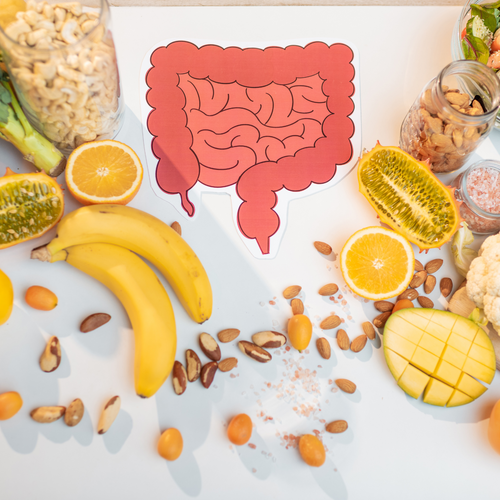What to remember:
- The stomach is constantly changing and its appearance varies throughout the day. A stomach on an empty stomach will not look the same as one after a meal, which is in the middle of digesting.
- Know that each belly is unique, so it is not interesting to compare yourself to others.
- Improving your lifestyle by implementing new habits can help you achieve your flat stomach goal.
Our attention often focuses on our stomach. We wish it were more like this, and less like that. Know that every stomach is unique, so there's no point comparing yourself to others. It's normal to end up with a small belly during the day. The stomach is constantly changing and its appearance varies throughout the day. A stomach on an empty stomach will not be the same as one after a meal, which is in the middle of digesting. And that's normal! If you want to feel more toned, have a flat stomach, and improve your gut health, we've gathered 8 (real) tips in this article to adopt better lifestyle habits, bringing you closer to your goal of a flat stomach. And it's not just for aesthetic reasons; reducing abdominal fat also means lowering your cardiovascular risks.
1 - Adopt good eating habits

Having a flat stomach can be promoted by adopting good eating habits, making sure to vary our diet and balance it throughout the day so that it provides everything our body needs to function optimally. Of course, it is recommended to consume fruits, vegetables, cereals, legumes and lean meat, while avoiding ultra-processed industrial foods which contain many additives that are harmful to health. For you, we have gathered 4 habits to implement in your daily life:
- Identify and limit foods that are difficult for you to digest: Every body is unique and reacts differently to foods. Some foods can cause bloating or digestive discomfort. Take the time to assess your feelings after meals and identify those that cause digestive issues. Limit or avoid these foods to promote harmonious digestion and a flatter stomach.
- Limit your salt intake: Salt can be a real enemy. Excessive salt consumption can lead to water retention, which makes you feel bloated and your stomach look bigger. To limit this, try reducing your salt intake by avoiding processed foods and cooking at home with herbs and spices to enhance the flavor.
- Don't force yourself to finish your plate: Although it may seem rude, not forcing yourself to finish your plate when you're no longer hungry is a great habit to adopt. Listening to your body and paying attention to these feelings of hunger/fullness helps you avoid overeating. We have dedicated an article to this approach: intuitive eating .
- Consume detox foods to benefit your body: Certain foods are known for their detoxifying properties, helping to eliminate toxins and promote healthy digestion. These include fresh, organic vegetables and fruits that are rich in fiber and antioxidants, seeds and nuts, lean proteins like fish, and legumes. If you're short on detox recipe ideas , don't hesitate to check out our dedicated article on this topic.
2 - Hydrate regularly and sufficiently

Staying hydrated regularly and sufficiently has many benefits. It facilitates the elimination of toxins accumulated in our body, improves the digestive process (goodbye slow transit), stimulates the metabolism and prevents water retention. Make sure you drink at least 1.5 to 2L of water per day to maintain optimal functioning of your body, have a flat stomach and better overall health. So remember to take your water bottle with you everywhere, that way you have no more excuses for not hydrating yourself throughout the day ! If you can't drink a lot of water, don't hesitate to make yourself infusions or teas, which can help you drink more and vary the tastes a little.
3 - Exercise regularly

We often fall into the trap of a sedentary lifestyle, spending long hours sitting at work or school. To counter this tendency, incorporating regular exercise into our daily lives is essential. Small changes, such as taking the stairs instead of the elevator or walking instead of driving, can already make a difference. Additionally, practicing a sport that makes us feel good, both physically and mentally, is an excellent option. Physical activity boosts metabolism and promotes fat burning, which can contribute to a flat stomach. However, it's important to keep in mind that it doesn't target weight loss in a specific area, but acts holistically on the entire body. In terms of exercise, we recommend core exercises, which are particularly effective for achieving a flat stomach, as they strengthen the abdominal muscles and activate the deep muscles, creating a solid foundation for a toned stomach.
4 - Learn to regulate your daily stress

You may not know it, but your stress can have a significant impact on your stomach. First, stress is responsible for an increase in the production of cortisol, the stress hormone, which can be associated with weight gain, particularly the accumulation of abdominal fat. In addition, stress can influence our eating habits and slow down digestion, thus contributing to weight gain in this area. But don't panic! There are plenty of solutions to help you regulate your daily stress: meditation, yoga, cardiac coherence... These will help you achieve a flat stomach !
5 - Practice the stomach vacuum technique
Still little known to everyone, the stomach vacuum, also called “false thoracic inspiration,” is a breathing technique that strengthens the abdominal muscles. Unlike the “classic” exercises we usually do to work the rectus abdominis (the famous six-pack), this method allows you to work the transverse abdominis. This hypopressive exercise works the muscles located deep in the abdominal wall and contributes to the flat stomach effect, without exerting pressure on the perineum. Indeed, by strengthening these deep muscles, it creates a natural sheath that supports your internal organs and pulls the internal muscles closer to the spine. This helps flatten the abdominal region and refine your waist. By practicing this technique regularly, you also improve your posture by strengthening the muscles that support the spine, thus promoting this flat stomach effect. This gentle breathing method is effective, but be careful, it must be done correctly!
For beginners:
- Starting Position: Lie on your back with your knees bent and your feet flat on the floor, shoulder-width apart. Place your arms at your sides.
- Inhale: Take a deep breath through your nose to fill your lungs, and be sure to engage your perineum at the end of this inhalation (as if you were holding back from going to the bathroom).
- Exhalation: Slowly exhale all the air from your lungs through your mouth and maintain the contraction.
- Hold: Once you have no more air, practice a false inhalation (no air coming in) while pulling in your stomach. Your navel should be drawn closer to your spine. Hold the contraction
- Release: Gradually release the contraction and inhale normally.
- Repetitions: Perform 5 to 10 repetitions, gradually increasing the hold time as you gain abdominal strength. To be effective, practice at least 2 to 3 times per week.
For more advanced levels:
Once you're comfortable, you can do this exercise sitting or standing. The most difficult way to do this exercise is on all fours, as it also requires you to fight gravity.
Our advice: It is recommended to exercise on an empty stomach or some time after meals, as this can make it difficult to perform and disrupt digestion.
6 - Treat yourself to a stomach massage

Massage alone won't help you get a flat stomach (don't forget about a healthy lifestyle!). However, getting a stomach massage can provide some benefits to help achieve a flat stomach. It can stimulate blood and lymphatic circulation in the abdominal area, improve digestion, and reduce bloating, which promotes better digestive function and a feeling of lightness. So , what types of stomach massage should you opt for? There are several that can help improve digestion and reduce bloating. Here are a few examples:
- Lymphatic massage: This massage aims to stimulate the lymphatic system, which plays a vital role in removing toxins and waste from the body. This type of massage involves gentle, rhythmic movements aimed at draining lymph and reducing swelling due to water retention.
- Abdominal Massage: Primarily focused on the stomach area, this massage can include various movements (kneading, pressing, smoothing, etc.) to stimulate blood and lymphatic circulation in the abdominal area, relax muscles, and relieve tension. It can be beneficial for improving digestion, reducing bloating, and promoting regular bowel function.
- Swedish Massage: This massage uses movements such as effleurage, kneading, friction, percussion, and stretching to relieve muscle tension, improve circulation, and promote overall relaxation. While not specifically focused on the abdomen, some practitioners may include gentle abdominal massage movements in the session.
- Shiatsu massage: This Japanese massage technique uses pressure on specific points on the body along energy meridians. In the abdomen, shiatsu can target acupressure points related to digestion and the body's energy balance.
7 - Make sure you get restful sleep

Our sleep impacts several aspects of health: our immunity, our concentration, our memory, our mental health, our skin, our hormones and even our weight! And yes, if you pay attention to the quality and quantity of your sleep, it can help you have a flat stomach . During sleep, the body regulates the production of essential hormones linked to metabolism, such as growth hormone, which can help improve fat metabolism and muscle development. In addition, sufficient sleep helps control appetite by regulating hunger (ghrelin) and satiety (leptin) hormones, which limits the famous cravings and overeating. Finally, good sleep reduces the stress level that we saw earlier was associated with weight gain. So now you have every reason to avoid taking your sleep lightly with shortened nights!




















